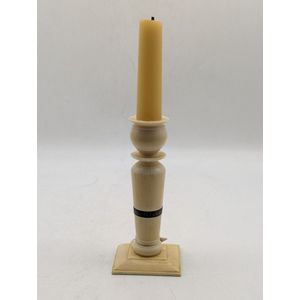
Rare Thomas Webb & Sons ivory cameo glass candlesticks, c. 1885
Thomas Webb & Sons, a rare pair of ivory cameo glass candlesticks, c. 1885, designed by George Woodall and painted by Jules Barbe, pattern I 499, decorated with classical foliage and floral motifs, the cameo work heightened in brown enamel, each base…

Victorian ivory walrus tusk candlesticks with silverplated accents, Sheffield
Pair late Victorian stained ivory walrus tusk & silverplated candlesticks by Joseph Rodgers & Sons, Sheffield, with detachable nozzles, the loaded square bases decorated with rosettes and swags, 41 cm high

19th Century Ivory Candlestick with Ebony Inlaid Ring
Antique ivory single candle stick, turned 19th century ivory candlestick with ebony inlaid ring

Ivory and Silver Candlesticks by Tony White
Tony White (Australian, 1942-2020), pair of ivory and sterling silver candlesticks, with sterling silver mounts, hallmarked (2), height 38 cm. Provenance: John Paradee, Double Bay, July 1986, the Estate of Irena Nebenzahl, Sydney

Ivory and Bakelite Candlesticks
A pair of early 20th century ivory and Bakelite column candlesticks, the amber toned, turned Bakelite nozzles on plain tapered long columns with single knop to the stepped rectangular spreading bases. Height 23 cm

Sri Lankan Ivory and Ebony Candlesticks
Pair of Sri Lankan ivory and ebony candlesticks, late 19th century/ early 20th century, bronze mounted (2), height 25.5 cm

Victorian gilt metal and ivory candlesticks, 11cm high
A pair of Victorian gilt metal and inlaid ivory candlesticks; 11 cm high

Edwardian Silver Plate Candlesticks with Stained Ivory Tusk
Pair Edwardian silver plate & stained ivory tusk candlesticks on engraved and beaded square bases by Rodgers 37.5 cm height

Anglo-Indian Ebony and Ivory Candlesticks, 19th Century
A small pair of ebony and ivory candlesticks, Anglo-Indian, 19th century, 10 cm high

Ivory & Silver Plate Candlesticks, Joseph Rodgers & Sons
A rare and exceptional pair of ivory and silver plate candlesticks, circa 1900; with maker's mark Joseph Rodgers & Sons Sheffield, pattern 2821, with generous floriform fluted dishes supported on ivory stems in their natural curved state and upon a…

French Colonial Ivory and Walnut Candlesticks
A pair of ivory and walnut twin branch candlesticks, French Colonial, circa 1930. 31 cm high

 Loading more...
Loading more...